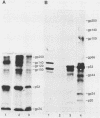Abstract
Antigenic and genomic relationships among tissue culture-adapted turkey enteric coronavirus (TCV) isolates, three strains of avian infectious bronchitis virus (IBV), and mammalian coronaviruses were investigated. Immunoblotting and immunoprecipitation experiments using polyclonal antisera showed that the four major structural proteins of TCV cross-reacted with the four homologous proteins of bovine enteric coronavirus (BCV), the N and M proteins of mouse hepatitis virus serotype 3, and the N protein of IBV. Close antigenic relationships between TCV and BCV were also established by seroneutralization and hemagglutination-inhibition. Of 49 monoclonal antibodies produced against either TCV or BCV, 11 differentiated the two viruses. Five of these monoclonal antibodies had neutralizing activities and were directed to either the peplomeric S (gp200-gp100) or hemagglutinin HE (gp140-gp65) glycoproteins. BCV cDNA probes tested on purified viral preparations and coronavirus-positive (by electron microscopy) fecal samples from diarrheic turkey poults confirmed the relatedness of TCV and BCV. The two viruses produced distinct cytopathic changes in HRT-18 cells in the presence of trypsin, whereas only TCV isolates were able to reproduce the clinical symptoms in turkey poults. Their matrix (M) proteins undergo different glycosylation processes.
Full text
PDF
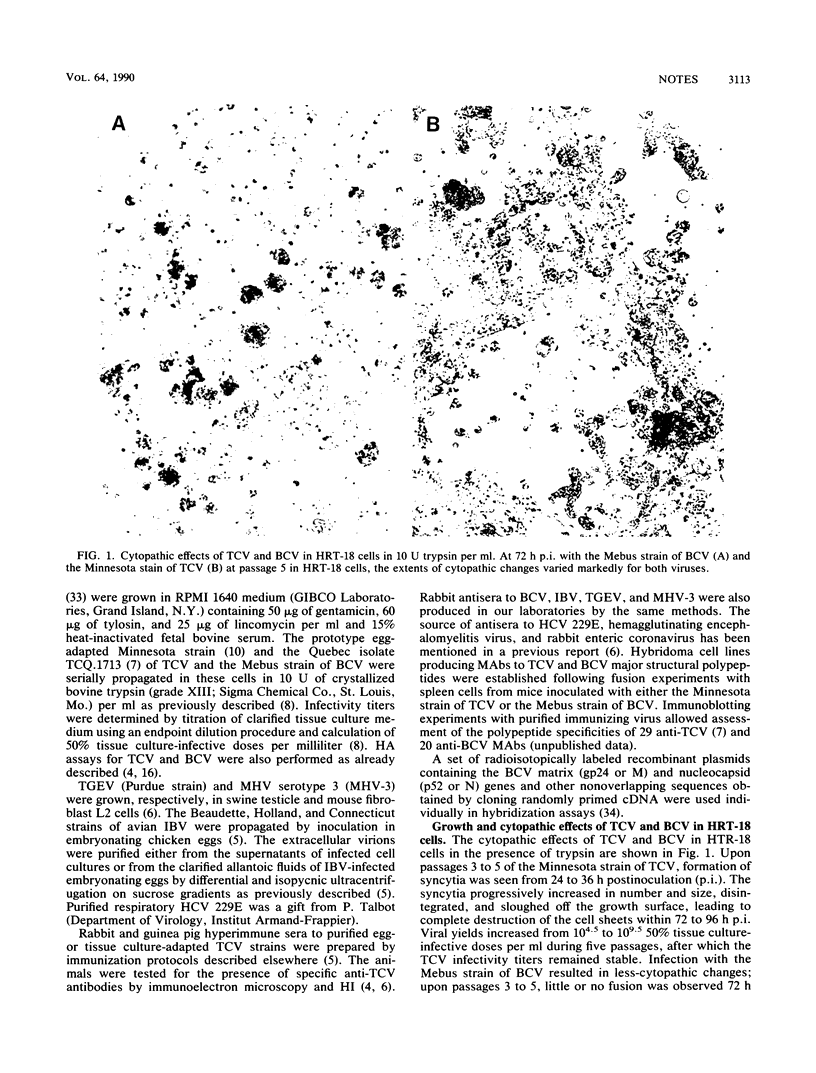
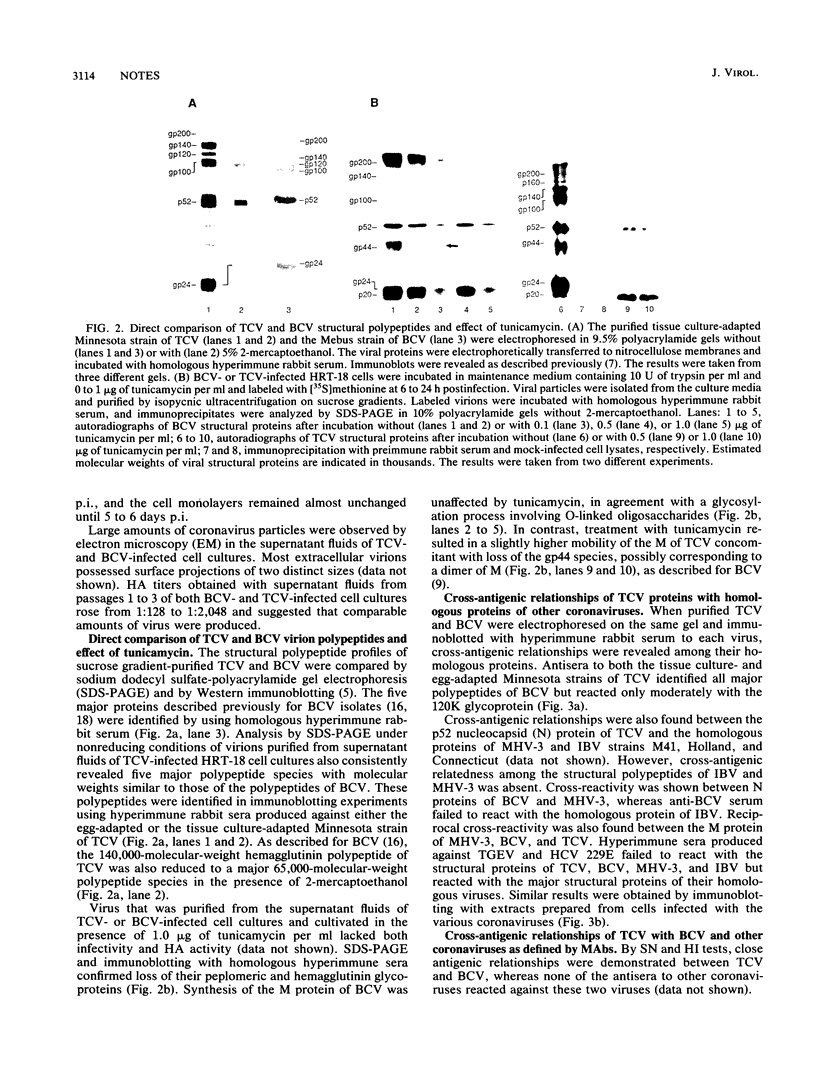

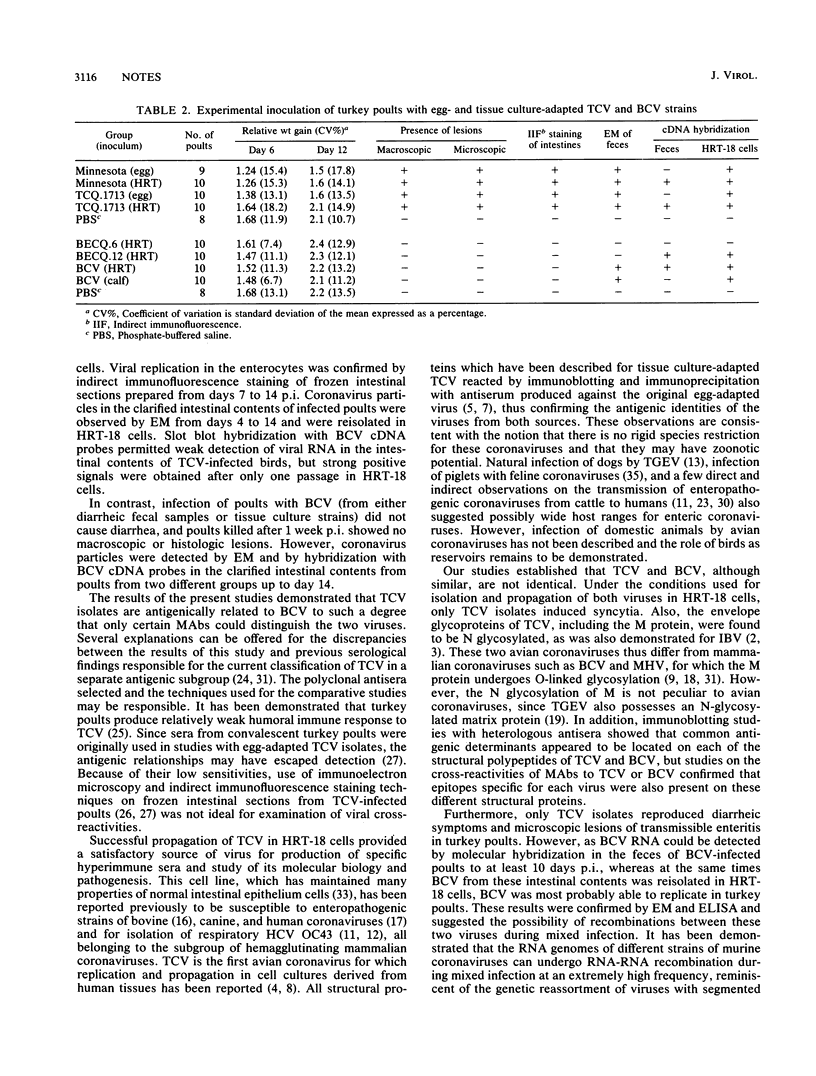
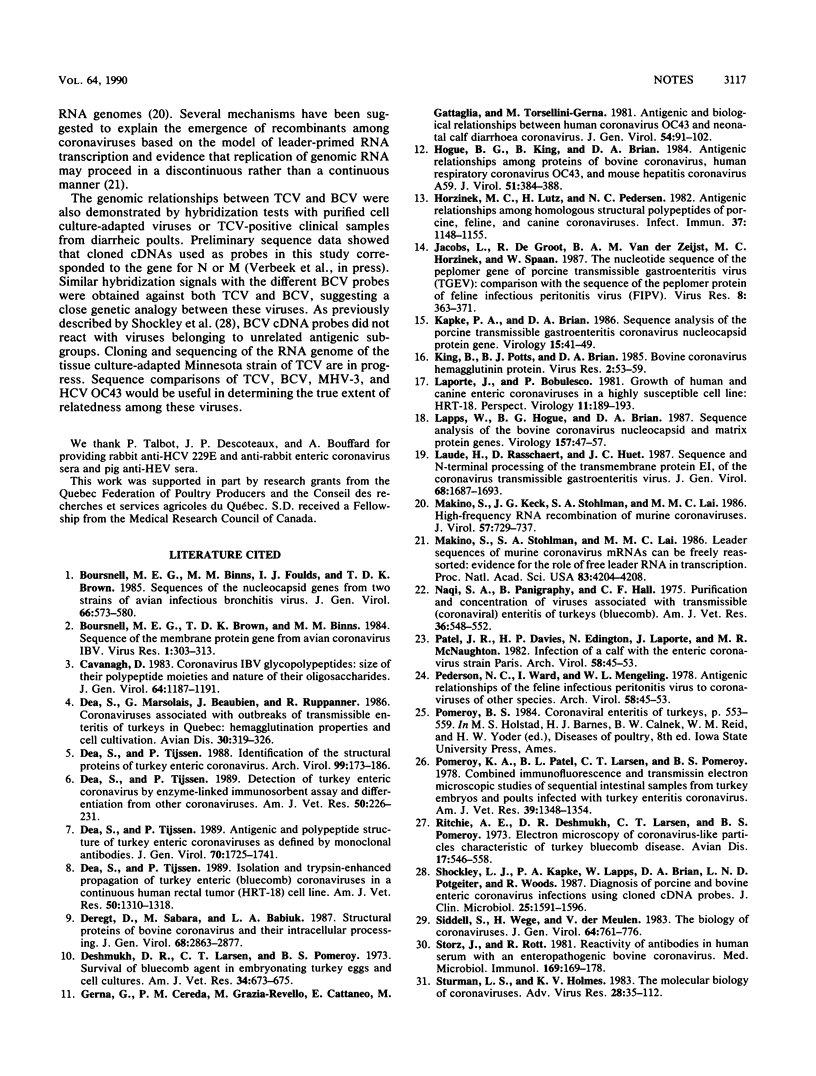
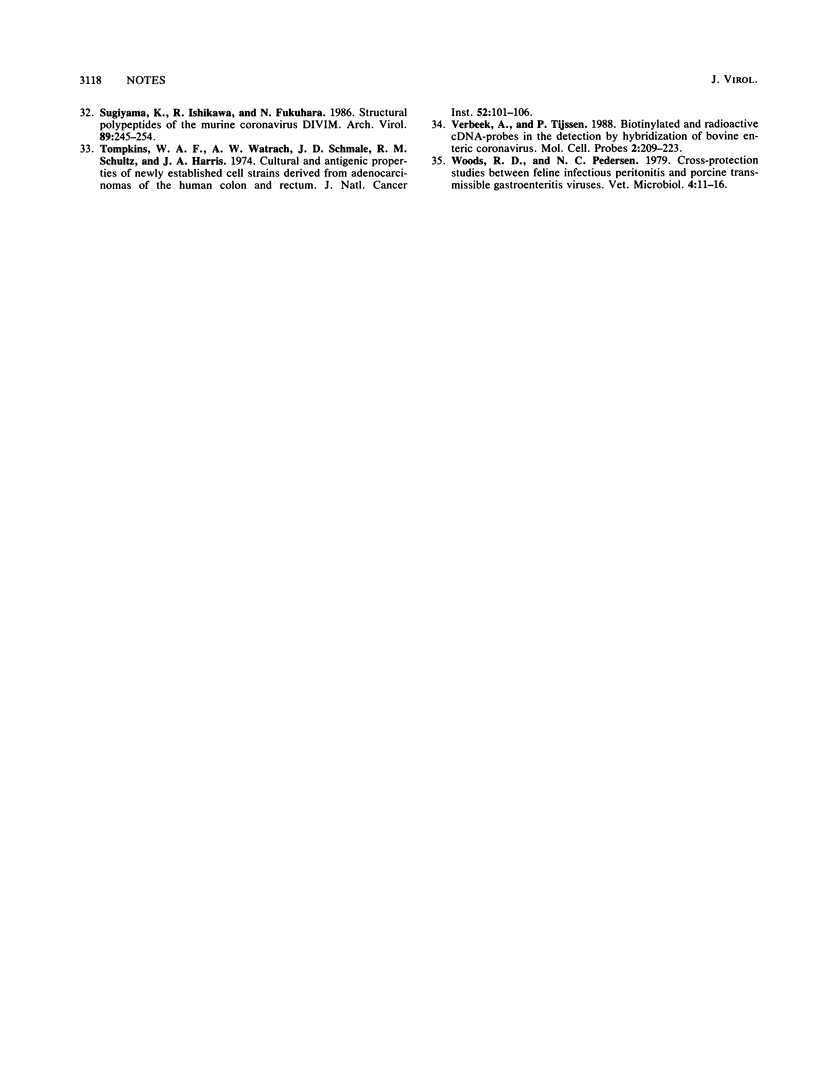
Images in this article
Selected References
These references are in PubMed. This may not be the complete list of references from this article.
- Boursnell M. E., Binns M. M., Foulds I. J., Brown T. D. Sequences of the nucleocapsid genes from two strains of avian infectious bronchitis virus. J Gen Virol. 1985 Mar;66(Pt 3):573–580. doi: 10.1099/0022-1317-66-3-573. [DOI] [PubMed] [Google Scholar]
- Boursnell M. E., Brown T. D., Binns M. M. Sequence of the membrane protein gene from avian coronavirus IBV. Virus Res. 1984;1(4):303–313. doi: 10.1016/0168-1702(84)90019-4. [DOI] [PMC free article] [PubMed] [Google Scholar]
- Cavanagh D. Coronavirus IBV glycopolypeptides: size of their polypeptide moieties and nature of their oligosaccharides. J Gen Virol. 1983 May;64(Pt 5):1187–1191. doi: 10.1099/0022-1317-64-5-1187. [DOI] [PubMed] [Google Scholar]
- Dea S., Garzon S., Tijssen P. Isolation and trypsin-enhanced propagation of turkey enteric (bluecomb) coronaviruses in a continuous human rectal adenocarcinoma cell line. Am J Vet Res. 1989 Aug;50(8):1310–1318. [PubMed] [Google Scholar]
- Dea S., Marsolais G., Beaubien J., Ruppanner R. Coronaviruses associated with outbreaks of transmissible enteritis of turkeys in Quebec: hemagglutination properties and cell cultivation. Avian Dis. 1986 Apr-Jun;30(2):319–326. [PubMed] [Google Scholar]
- Dea S., Tijssen P. Antigenic and polypeptide structure of turkey enteric coronaviruses as defined by monoclonal antibodies. J Gen Virol. 1989 Jul;70(Pt 7):1725–1741. doi: 10.1099/0022-1317-70-7-1725. [DOI] [PubMed] [Google Scholar]
- Dea S., Tijssen P. Detection of turkey enteric coronavirus by enzyme-linked immunosorbent assay and differentiation from other coronaviruses. Am J Vet Res. 1989 Feb;50(2):226–231. [PubMed] [Google Scholar]
- Dea S., Tijssen P. Identification of the structural proteins of turkey enteric coronavirus. Arch Virol. 1988;99(3-4):173–186. doi: 10.1007/BF01311068. [DOI] [PMC free article] [PubMed] [Google Scholar]
- Deregt D., Sabara M., Babiuk L. A. Structural proteins of bovine coronavirus and their intracellular processing. J Gen Virol. 1987 Nov;68(Pt 11):2863–2877. doi: 10.1099/0022-1317-68-11-2863. [DOI] [PubMed] [Google Scholar]
- Deshmukh D. R., Larsen C. T., Pomeroy B. S. Survival of bluecomb agent in embryonating turkey eggs and cell cultures. Am J Vet Res. 1973 May;34(5):673–675. [PubMed] [Google Scholar]
- Gerna G., Cereda P. M., Revello M. G., Cattaneo E., Battaglia M., Gerna M. T. Antigenic and biological relationships between human coronavirus OC43 and neonatal calf diarrhoea coronavirus. J Gen Virol. 1981 May;54(Pt 1):91–102. doi: 10.1099/0022-1317-54-1-91. [DOI] [PubMed] [Google Scholar]
- Hogue B. G., King B., Brian D. A. Antigenic relationships among proteins of bovine coronavirus, human respiratory coronavirus OC43, and mouse hepatitis coronavirus A59. J Virol. 1984 Aug;51(2):384–388. doi: 10.1128/jvi.51.2.384-388.1984. [DOI] [PMC free article] [PubMed] [Google Scholar]
- Horzinek M. C., Lutz H., Pedersen N. C. Antigenic relationships among homologous structural polypeptides of porcine, feline, and canine coronaviruses. Infect Immun. 1982 Sep;37(3):1148–1155. doi: 10.1128/iai.37.3.1148-1155.1982. [DOI] [PMC free article] [PubMed] [Google Scholar]
- Jacobs L., de Groot R., van der Zeijst B. A., Horzinek M. C., Spaan W. The nucleotide sequence of the peplomer gene of porcine transmissible gastroenteritis virus (TGEV): comparison with the sequence of the peplomer protein of feline infectious peritonitis virus (FIPV). Virus Res. 1987 Nov;8(4):363–371. doi: 10.1016/0168-1702(87)90008-6. [DOI] [PMC free article] [PubMed] [Google Scholar]
- Kapke P. A., Brian D. A. Sequence analysis of the porcine transmissible gastroenteritis coronavirus nucleocapsid protein gene. Virology. 1986 May;151(1):41–49. doi: 10.1016/0042-6822(86)90102-9. [DOI] [PMC free article] [PubMed] [Google Scholar]
- King B., Potts B. J., Brian D. A. Bovine coronavirus hemagglutinin protein. Virus Res. 1985 Feb;2(1):53–59. doi: 10.1016/0168-1702(85)90059-0. [DOI] [PMC free article] [PubMed] [Google Scholar]
- Lapps W., Hogue B. G., Brian D. A. Sequence analysis of the bovine coronavirus nucleocapsid and matrix protein genes. Virology. 1987 Mar;157(1):47–57. doi: 10.1016/0042-6822(87)90312-6. [DOI] [PMC free article] [PubMed] [Google Scholar]
- Laude H., Rasschaert D., Huet J. C. Sequence and N-terminal processing of the transmembrane protein E1 of the coronavirus transmissible gastroenteritis virus. J Gen Virol. 1987 Jun;68(Pt 6):1687–1693. doi: 10.1099/0022-1317-68-6-1687. [DOI] [PubMed] [Google Scholar]
- Makino S., Keck J. G., Stohlman S. A., Lai M. M. High-frequency RNA recombination of murine coronaviruses. J Virol. 1986 Mar;57(3):729–737. doi: 10.1128/jvi.57.3.729-737.1986. [DOI] [PMC free article] [PubMed] [Google Scholar]
- Makino S., Stohlman S. A., Lai M. M. Leader sequences of murine coronavirus mRNAs can be freely reassorted: evidence for the role of free leader RNA in transcription. Proc Natl Acad Sci U S A. 1986 Jun;83(12):4204–4208. doi: 10.1073/pnas.83.12.4204. [DOI] [PMC free article] [PubMed] [Google Scholar]
- Naqi S. A., Panigrahy B., Hall C. F. Purification and concentration of viruses associated with transmissible (coronaviral) enteritis of turkeys (bluecomb). Am J Vet Res. 1975 Apr;36(4 Pt 2):548–552. [PubMed] [Google Scholar]
- Pedersen N. C., Ward J., Mengeling W. L. Antigenic relationship of the feline infectious peritonitis virus to coronaviruses of other species. Arch Virol. 1978;58(1):45–53. doi: 10.1007/BF01315534. [DOI] [PMC free article] [PubMed] [Google Scholar]
- Pomeroy K. A., Patel B. L., Larsen C. T., Pomeroy B. S. Combined immunofluorescence and transmission electron microscopic studies of sequential intestinal samples from turkey embryos and poults infected with turkey enteritis coronavirus. Am J Vet Res. 1978 Aug;39(8):1348–1354. [PubMed] [Google Scholar]
- Ritchie A. E., Deshmukh D. R., Larsen C. T., Pomeroy B. S. Electron microscopy of coronavirus-like particles characteristic of turkey bluecomb disease. Avian Dis. 1973 Jul-Sep;17(3):546–558. [PubMed] [Google Scholar]
- Shockley L. J., Kapke P. A., Lapps W., Brian D. A., Potgieter L. N., Woods R. Diagnosis of porcine and bovine enteric coronavirus infections using cloned cDNA probes. J Clin Microbiol. 1987 Sep;25(9):1591–1596. doi: 10.1128/jcm.25.9.1591-1596.1987. [DOI] [PMC free article] [PubMed] [Google Scholar]
- Siddell S., Wege H., Ter Meulen V. The biology of coronaviruses. J Gen Virol. 1983 Apr;64(Pt 4):761–776. doi: 10.1099/0022-1317-64-4-761. [DOI] [PubMed] [Google Scholar]
- Storz J., Rott R. Reactivity of antibodies in human serum with antigens of an enteropathogenic bovine coronavirus. Med Microbiol Immunol. 1981;169(3):169–178. doi: 10.1007/BF02123590. [DOI] [PMC free article] [PubMed] [Google Scholar]
- Sturman L. S., Holmes K. V. The molecular biology of coronaviruses. Adv Virus Res. 1983;28:35–112. doi: 10.1016/S0065-3527(08)60721-6. [DOI] [PMC free article] [PubMed] [Google Scholar]
- Sugiyama K., Ishikawa R., Fukuhara N. Structural polypeptides of the murine coronavirus DVIM. Arch Virol. 1986;89(1-4):245–254. doi: 10.1007/BF01309893. [DOI] [PMC free article] [PubMed] [Google Scholar]
- Verbeek A., Tijssen P. Biotinylated and radioactive cDNA probes in the detection by hybridization of bovine enteric coronavirus. Mol Cell Probes. 1988 Sep;2(3):209–223. doi: 10.1016/0890-8508(88)90005-9. [DOI] [PMC free article] [PubMed] [Google Scholar]





